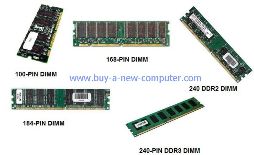Desktop Computer Memory Types and How to Identify Them
In this page we are going to discuss the different desktop computer memory types that someone can find available in today’s computer market. We will also see how these types of RAM are categorized and how they can be identified. Also a little history about the generations of the different computer modules.
Computer memory evolved as technology progressed and continues to evolve introducing every now and then new types of computer memory. The dominant types of RAM right now are the DDR2 and DDR3 SDRAM. New models that offer higher and higher performance become available every month pushing the existing technology to its limits. Progress is so fast that your new computer will be considered “old” after six months. But let’s start from the beginning.
Take a look at the market today under the desktop computer memory products . You can find and buy the following types of RAM:
- SDRAM – 168 pin
- DDR SDRAM – 184 pin
- DDR2 SDRAM – 240 pin
- DDR3 SDRAM – 240 pin
History of Computer Memory Types
These are all generations of the Synchronous Dynamic Random Access Memory (SDRAM). Older SIMMs (Single In-line Memory Modules) or DIMMs (Dual in-line Memory Modules) 100-pin, may also be found for sale but they have a low performance/price ratio as they are considered obsolete and very difficult to find. SIMMs or DIMMs are just another name for the computer memory modules. A memory module can be found as DIMM module or just DIMM. All these names are for the same thing.The SDRAM is the dominant RAM type that is used up to now since 1993. This type of dynamic random access memory is used in all desktop computers. The desktop computer memory types that we are talking about are in fact variations of the SDRAM memory.
Every new variation of SDRAM offered greater performance by actually supporting a higher range of clock speeds. But there are also downsides to the higher clock speed and this is the increase of the CAS latency. CAS latency is a performance factor of the memory module. The lower the CAS latency the faster the memory is. The below table summarizes all this information.

As you see, the DDR technology doubles the bandwidth of the DIMM clock frequency. This is the effective bandwidth. Each RAM type supports a specific clock frequency range. The above values show the speed in MHz that computer memory modules support. DIMMs at a higher clock speeds, in every SDRAM generation, presented in the market at a later time.
Also the typical voltages are not standard for all the memory modules. For example some DDR2 modules need a voltage of 2.1 or 2.2 in order to work at their advertised frequency.
How to Identify Computer Memory Modules From their Description
An easy way to identify all the above computer memory types is from their name description. Every memory module in its name description has a code that looks like DDRy-xxxxor PCy-xxxx. What does these codes means?DDRy-xxxx : y=nothing in case of DDR, y=2 in case of DDR2 and y=3 in case of DDR3. Xxxx= Effective Bandwidth of the memory module.
Example: DDR2-1066 means a DDR2 memory type with an advertised bandwidth of 1066 MHz.
PCy-xxxx: y is the same with the previous code. Xxxx= 8x(Effective Bandwidth).
Example: PC-3200 is a DDR memory having an effective bandwidth of 3200/8 = 400 MHz.
This is the general rule about the PCy-xxx code but it is not always followed by manufacturers. You may find it slightly increased in some computer memory types.
So now when you shop for desktop computer memory you will be able to identify and understand all these mysterious codes in product descriptions. Besides you can save time because you don’t have to enter the product details in order to check the bandwidth of the memory modules.
No comments:
Post a Comment